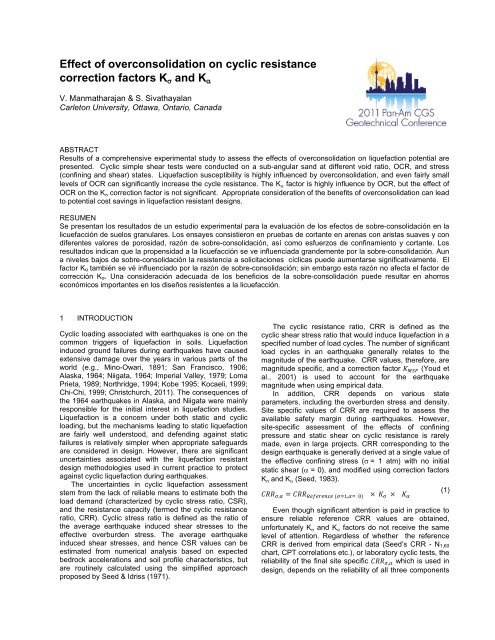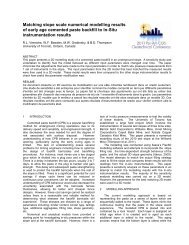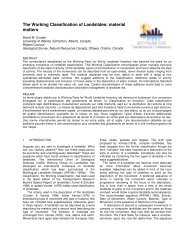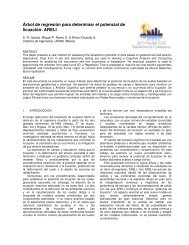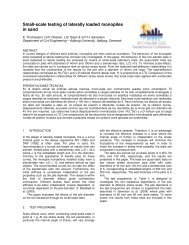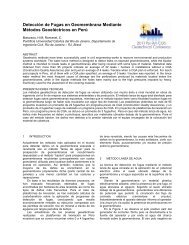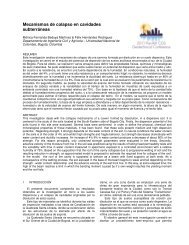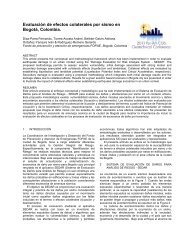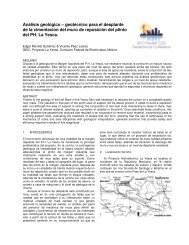MS Word Technical Paper Template
MS Word Technical Paper Template
MS Word Technical Paper Template
You also want an ePaper? Increase the reach of your titles
YUMPU automatically turns print PDFs into web optimized ePapers that Google loves.
Effect of overconsolidation on cyclic resistance<br />
correction factors K σ and K α<br />
V. Manmatharajan & S. Sivathayalan<br />
Carleton University, Ottawa, Ontario, Canada<br />
ABSTRACT<br />
Results of a comprehensive experimental study to assess the effects of overconsolidation on liquefaction potential are<br />
presented. Cyclic simple shear tests were conducted on a sub-angular sand at different void ratio, OCR, and stress<br />
(confining and shear) states. Liquefaction susceptibility is highly influenced by overconsolidation, and even fairly small<br />
levels of OCR can significantly increase the cycle resistance. The K α factor is highly influence by OCR, but the effect of<br />
OCR on the K σ correction factor is not significant. Appropriate consideration of the benefits of overconsolidation can lead<br />
to potential cost savings in liquefaction resistant designs.<br />
RESUMEN<br />
Se presentan los resultados de un estudio experimental para la evaluación de los efectos de sobre-consolidación en la<br />
licuefacción de suelos granulares. Los ensayes consistieron en pruebas de cortante en arenas con aristas suaves y con<br />
diferentes valores de porosidad, razón de sobre-consolidación, así como esfuerzos de confinamiento y cortante. Los<br />
resultados indican que la propensidad a la licuefacción se ve influenciada grandemente por la sobre-consolidación. Aun<br />
a niveles bajos de sobre-consolidación la resistencia a solicitaciones cíclicas puede aumentarse significativamente. El<br />
factor K α también se vé influenciado por la razón de sobre-consolidación; sin embargo esta razón no afecta el factor de<br />
corrección K σ. Una consideración adecuada de los beneficios de la sobre-consolidación puede resultar en ahorros<br />
económicos importantes en los diseños resistentes a la licuefacción.<br />
1 INTRODUCTION<br />
Cyclic loading associated with earthquakes is one on the<br />
common triggers of liquefaction in soils. Liquefaction<br />
induced ground failures during earthquakes have caused<br />
extensive damage over the years in various parts of the<br />
world (e.g., Mino-Owari, 1891; San Francisco, 1906;<br />
Alaska, 1964; Niigata, 1964; Imperial Valley, 1979; Loma<br />
Prieta, 1989; Northridge, 1994; Kobe 1995; Kocaeli, 1999;<br />
Chi-Chi, 1999; Christchurch, 2011). The consequences of<br />
the 1964 earthquakes in Alaska, and Niigata were mainly<br />
responsible for the initial interest in liquefaction studies.<br />
Liquefaction is a concern under both static and cyclic<br />
loading, but the mechanisms leading to static liquefaction<br />
are fairly well understood, and defending against static<br />
failures is relatively simpler when appropriate safeguards<br />
are considered in design. However, there are significant<br />
uncertainties associated with the liquefaction resistant<br />
design methodologies used in current practice to protect<br />
against cyclic liquefaction during earthquakes.<br />
The uncertainties in cyclic liquefaction assessment<br />
stem from the lack of reliable means to estimate both the<br />
load demand (characterized by cyclic stress ratio, CSR),<br />
and the resistance capacity (termed the cyclic resistance<br />
ratio, CRR). Cyclic stress ratio is defined as the ratio of<br />
the average earthquake induced shear stresses to the<br />
effective overburden stress. The average earthquake<br />
induced shear stresses, and hence CSR values can be<br />
estimated from numerical analysis based on expected<br />
bedrock accelerations and soil profile characteristics, but<br />
are routinely calculated using the simplified approach<br />
proposed by Seed & Idriss (1971).<br />
The cyclic resistance ratio, CRR is defined as the<br />
cyclic shear stress ratio that would induce liquefaction in a<br />
specified number of load cycles. The number of significant<br />
load cycles in an earthquake generally relates to the<br />
magnitude of the earthquake. CRR values, therefore, are<br />
magnitude specific, and a correction factor K <strong>MS</strong>F (Youd et<br />
al., 2001) is used to account for the earthquake<br />
magnitude when using empirical data.<br />
In addition, CRR depends on various state<br />
parameters, including the overburden stress and density.<br />
Site specific values of CRR are required to assess the<br />
available safety margin during earthquakes. However,<br />
site-specific assessment of the effects of confining<br />
pressure and static shear on cyclic resistance is rarely<br />
made, even in large projects. CRR corresponding to the<br />
design earthquake is generally derived at a single value of<br />
the effective confining stress (σ = 1 atm) with no initial<br />
static shear (α = 0), and modified using correction factors<br />
K σ and K α (Seed, 1983).<br />
(1)<br />
CRR σ,α = CRR Reference (σ=1,α= 0) × K σ × K α<br />
Even though significant attention is paid in practice to<br />
ensure reliable reference CRR values are obtained,<br />
unfortunately K σ and K α factors do not receive the same<br />
level of attention. Regardless of whether the reference<br />
CRR is derived from empirical data (Seed’s CRR - N 1,60<br />
chart, CPT correlations etc.), or laboratory cyclic tests, the<br />
reliability of the final site specific CRR σ,α which is used in<br />
design, depends on the reliability of all three components
in eq. (1). It is not logical design practice to pay extensive<br />
attention to one component, and not to the others.<br />
It is widely recognized that overconsolidation normally<br />
increases the dilative tendencies, and leads to stronger<br />
response (Tatsuoka, 1974; Ladd et al, 1977; Skempton,<br />
1986). Seed & Peacock (1971) originally demonstrated<br />
that cyclic resistance increases with overconsolidation.<br />
Ishihara et al. (1978) noted that even small levels of OCR<br />
can significantly increase the cyclic resistance. Various<br />
researchers have reported on the effects of OCR on cyclic<br />
resistance (Ishihara & Takatsu, 1979; Nagase et al 2004;<br />
Adalier & Elgamal, 2005), but its implications on current<br />
design methods have not been fully explored. A<br />
comprehensive and systematic research that assesses<br />
the effects of OCR and its implications to current seismic<br />
design practice can lead to better design guidelines.<br />
2 K σ AND K α FACTORS: BACKGROUND<br />
Cyclic resistance of sands depends on various initial state<br />
parameters, such as the fabric, void ratio (or density),<br />
overburden (or confining) stress, initial static shear and<br />
prior stress history. The basic understanding of the effects<br />
of these variables can only be derived from systematic<br />
experimental research. The focus of the research<br />
reported in the literature has mainly been limited to the<br />
effects of density, confining and static shear stress levels.<br />
The implications of changing density are readily<br />
understood, and appropriately considered in design.<br />
Increasing confining stresses tend to promote more<br />
contractive response, and as a result the cyclic<br />
resistance, quantified by CRR, decreases with increasing<br />
confining stress. Significant advances have been made in<br />
understanding the effects of confining stress level, and a<br />
correction factor K σ , defined as the cyclic resistance ratio<br />
at a given stress level to that at a reference state (Seed,<br />
1983), as shown in equation (2) is commonly used to<br />
account for its effects.<br />
τ cy<br />
′<br />
σ′ causing liquefaction at σ v<br />
K σ = v<br />
τ cy<br />
σ′ causing liquefaction at σ ′ v = 1 atm<br />
v<br />
K σ values were initially considered to be dependent on<br />
confining stress level alone (Seed, 1983; Seed & Harder,<br />
1990). Subsequent experimental research (Vaid et al.<br />
1985; Vaid & Thomas, 1995; Vaid & Sivathayalan, 1996;<br />
Haynes & Olsen, 1998) has indicated that K σ is<br />
dependent on both confining stress levels, and relative<br />
density, and these findings have been incorporated in the<br />
consensus report of the NCEER workshop (Youd et al.<br />
2001). The loading mode effects reported by Vaid &<br />
Sivathayalan (1996) are not explicitly considered in<br />
practice, but the values commonly used in practice (Youd<br />
et al. 2001) are somewhat conservative than the lower<br />
bound values that correspond to the weaker simple shear<br />
loading mode.<br />
Fig. 1 shows the range of K σ values reported in recent<br />
literature. Boulanger & Idriss (2004) K σ values imply that<br />
Haynes & Olsen (1998), Youd et al. (2001) are somewhat<br />
conservative. Boulanger & Idriss (2004) values are<br />
closest to values reported by Vaid & Sivathayalan (1996).<br />
The largest deviations between these two proposals are<br />
noted at the looser states. Regardless of which K σ value<br />
is adopted in design practice, these values are considered<br />
fairly reliable. However, these data correspond to normally<br />
consolidated soils only, and the applicability of the current<br />
K σ factors to over consolidated sands has not been<br />
properly addressed in the literature<br />
The effects of the initial static shear stress τ st on cyclic<br />
resistance is accounted for by a similar correction factor<br />
K α which is defined as the ratio of CRR with static shear<br />
to that without as shown in equation (3).<br />
(2)<br />
Figure 1: Range of K σ values proposed in the literature
K α =<br />
τ cy<br />
σ′ causing liquefaction with τ st<br />
v<br />
τ cy<br />
σ′ causing liquefaction with no static shear<br />
v<br />
The static shear stress ratio parameter α is defined as the<br />
ratio of shear stress on the horizontal plane to the vertical<br />
effective overburden stress in most scenarios, except in<br />
experimental research using cyclic triaxial tests.<br />
Increasing static shear tends to increase the cyclic<br />
resistance in dense sands, but it often significantly<br />
reduces the cyclic resistance of loose sands. A range of<br />
K α values have been proposed in the literature, generally<br />
as a function of α and relative density, but recent studies<br />
(Boulanger & Idriss, 2003; Sivathayalan & Ha, 2006)<br />
indicate that relative density may not be an appropriate<br />
parameter to quantify K α. As a result of the uncertainties<br />
of the effects of loading mode, and material<br />
characteristics on K α , this correction is not as widely used<br />
in practice, especially when dealing with dense sands<br />
because of the expectation that ignoring this effect would<br />
lead to a conservative design. However, Sivathayalan &<br />
Ha (2006) point out that ignoring the static shear<br />
correction might lead to unsafe designs, even in dense<br />
sands, if the sand at the denser state deforms<br />
contractively.<br />
3 EXPERIMENTATION & MATERIALS<br />
A comprehensive experimental study was undertaken at<br />
the geotechnical research laboratory at Carleton<br />
University to assess the effects of overconsolidation on<br />
liquefaction potential, and correction factors K σ and K α .<br />
Cyclic simple shear tests were performed on normally<br />
consolidated, and over consolidated sands at different<br />
density and initial stress states. The loading conditions in<br />
a simple shear device closely simulate the in-situ stress<br />
conditions due to vertically propagating shear waves.<br />
Details of the test device and properties of the tested sand<br />
are provided in this section.<br />
3.1 Cyclic simple shear device<br />
The NGI type device (Bjerrum & Landva 1966) that was<br />
used to carry out the simple shear tests is shown in Figure<br />
1. The dimensions of the test specimen are 63.5mm in<br />
diameter by about 20mm height. Such a small aspect ratio<br />
is used to reduce the stress non-uniformities present in<br />
simple shear tests. Specimens are confined using a<br />
steel-wire reinforced membrane to facilitate constant<br />
volume testing during shear loading. The pore pressure in<br />
constant volume simple shear tests is always<br />
atmospheric, and the change in total vertical stress during<br />
shear equals the excess pore pressure generated in an<br />
equivalent undrained test (Dyvik et al. 1987).<br />
Consolidation stresses are applied by a pneumatic<br />
piston placed beneath the specimen, and cyclic shear can<br />
be imposed either under a stress controlled mode using a<br />
double acting piston, or under strain controlled mode<br />
using a stepper motor drive in this device. All cyclic tests<br />
reported herein were carried out under stress controlled<br />
(3)<br />
loading mode. Cyclic shear stresses were controlled by an<br />
electro-pneumatic transducer, and a uniform sinusoidal<br />
shear stress was applied at a frequency of 0.1 Hz. Care<br />
was taken to ensure that essentially constant cyclic shear<br />
stress amplitude is maintained throughout the loading. A<br />
high speed, high-resolution A/D card was used for data<br />
acquisition and control, and at least 64 data points were<br />
recorded per loading cycle. This permits an examination<br />
of the mechanism responsible for the development of<br />
strains within the loading cycle. All stresses were<br />
measured with resolutions of about 0.1kPa and strains<br />
with resolutions of about 10 –4 .<br />
3.2 Test Material<br />
Cyclic simple shear tests were carried out on Fraser Delta<br />
sand. This semi-angular sand was dredged near<br />
Abbotsford, British Columbia. The natural material was<br />
processed to remove the fine particles passing #200 sieve<br />
and those retained in #20 sieve. This provides a fairly<br />
uniform sand with a mean diameter of 0.30mm, and<br />
uniformity coefficient of 2.9. Such uniform material is<br />
essential for fundamental laboratory studies that require<br />
several repeatable, homogeneous specimens be<br />
reconstituted in the laboratory. Similar material has been<br />
used in several past studies reported in the literature<br />
(Vaid and Thomas, 1995; Vaid and Sivathayalan, 2000).<br />
The maximum and minimum void ratio of this batch of<br />
Fraser River sand determined according to the ASTM<br />
standard test methods is 0.806 and 0.509 respectively.<br />
While the mineral composition of this sand is similar to the<br />
various batches of Fraser River sand discussed in the<br />
literature the differences in the gradation, and the<br />
geographical origin cause fairly significant changes in the<br />
maximum and minimum void ratio. Such changes<br />
between different batches of Fraser Delta sands have<br />
been reported previously as well.<br />
3.3 Reconstitution Method & Consolidation process<br />
Undrained response of sands, and thus liquefaction<br />
potential are highly dependent on the soil fabric that<br />
ensues during the natural deposition process in-situ (Vaid<br />
Figure 2: Simple shear device at Carleton University
et al. 1999). Different reconstitution methods result in<br />
different fabric, and the method of reconstitution used in<br />
the laboratory should simulate the natural deposition<br />
process, if laboratory results are to be applied to in-situ<br />
soils with confidence.<br />
Simple shear tests in this research study were<br />
conducted on specimens reconstituted using the dry<br />
pluviation method. This technique yields uniform and<br />
repeatable specimens, which is a key requirement in<br />
fundamental studies that attempt to assess the effects of<br />
state variables. Fraser Delta sands are deposited in a<br />
fluvial environment in nature, and hence water pluviation<br />
would have been better at simulating the natural<br />
deposition process. However, previous studies show that<br />
differences between the two pluviation techniques are<br />
relatively minor in clean sands (Vaid et al. 1999), and the<br />
presence of fines is generally responsible for the<br />
structural differences (McGowan 1974) between pluviated<br />
specimens. Both sands tested herein are fairly clean with<br />
negligible amount of fines below #200 sieve, and hence<br />
both pluviation methods are expected to yield similar<br />
response.<br />
Specimens were reconstituted at the loosest state,<br />
and higher densities, when needed were obtained by<br />
applying low-energy, high frequency vertical vibrations<br />
under a small seating load of about 5 kPa. Void ratio of<br />
the specimens was confidently determined using the<br />
volume of the cavity and mass of the solids. After<br />
reconstitution specimens were moved to the simple shear<br />
device and a seating load of about 15 kPa was applied.<br />
Consolidation stresses were applied along the required α<br />
line for initial states with a static shear stress on the<br />
horizontal plane. Target OCR values were realised by<br />
loading, and unloading the specimen along the same α<br />
line. Consolidation process of specimens without initial<br />
static shear is similar to 1-D consolidation, and 1-D<br />
rebound in the case of overconsolidated specimens.<br />
respectively. Cyclic mobility was clearly the mechanism<br />
leading to liquefaction in overconsolidated soils. The<br />
maximum excess pore pressure in the tests varies<br />
between 95 – 98%, and no trend was noted depending on<br />
OCR. However, the rate of excess pore pressure<br />
generation decreases with increasing OCR on account of<br />
the increasing dilative tendencies in the soil. After 5 cycles<br />
of loading at CSR = 0.15, the normally consolidated soil<br />
generated about 92% of peak excess pore water<br />
pressure, but the peak excess pore pressure in sands at<br />
OCR values of 1.5, and were about 30%, and 2%<br />
respectively. Sand at OCR = 3 and higher developed<br />
negative excess pore water pressures during the early<br />
stages of loading. Such reduction in excess pore pressure<br />
generation is the key reason for the increased cyclic<br />
capacity in overconsolidated sands.<br />
4 TEST RESULTS & DISCUSSION<br />
Cyclic simple shear tests were conducted at 100, 200 and<br />
400 kPa vertical consolidation stress over a wide range of<br />
relative density states. A comprehensive series of tests<br />
were conducted on normally consolidated sands (OCR =<br />
1), and those overconsolidated to OCR values of 1.5 and<br />
2.0. A select number of tests were run on specimens<br />
overconsolidated to higher OCR values of 4, 8 & 16. The<br />
effect of initial static shear was assessed at a confining<br />
stress level of 100 kPa, at OCR values of 1, 1.5 & 2, and<br />
at α = 0.2, but over a range of density states.<br />
4.1 Cyclic Resistance & OCR<br />
Figure 3 shows the results of four cyclic tests at a fixed<br />
consolidation stress level of 200 kPa, and subjected to a<br />
constant CSR of 0.15. The relative density states of the<br />
specimens vary somewhat, but the changes are not<br />
significant, however, one of the specimens was normally<br />
consolidated, and the others were subjected to a stress<br />
history to yield different OCR values (1.5, 2, & 3). The<br />
number of cycles to liquefaction based on a strain criteria<br />
was 6, 13, 59 and 119 for OCR = 1.0, 1.5, 2.0, and 3.0<br />
Figure 3: Cyclic test results at different OCR values<br />
At each confining stress and OCR levels, tests were<br />
conducted at different density states at multiple CSR<br />
values. The data is plotted to yield the variation of<br />
number of cycles with relative density at each CSR as<br />
shown in Figure 4. This allowed the determination of the<br />
number of cycles to liquefaction at any relative density for<br />
the given CSR. The same plot also permits the<br />
determination of the cyclic resistance ratio CRR, and its<br />
variation with density, confining stress levels, and OCR.<br />
Figure 5(a) presents a summary of the test data in<br />
form of number of cycles to liquefaction (N) vs. OCR for
Figure 4: Dependence of cyclic simple shear resistance on relative density at different OCR values<br />
specimens consolidated to a relative density of D r = 41%<br />
and a confining stress level of 200 kPa at two cyclic stress<br />
ratio values. This illustrates the exponential increase in<br />
the number of cycles to liquefaction as OCR increases.<br />
Same data is plotted as a ratio of the number of cycles to<br />
liquefaction in overconsolidated soils to that in normally<br />
consolidated soils, termed K OCN in Figure 5(b). The rate<br />
of increase in K OCN is higher at lower CSR = 0.15<br />
compared to CSR = 0.26 indicating that much stronger<br />
response compared to that of normally consolidated<br />
sands can be expected from overconsolidated soils under<br />
small levels of shaking.<br />
4.2 Cyclic resistance ratio, CRR<br />
The cyclic resistance ratio, CRR was derived from the<br />
experimental database for normally consolidated and<br />
overconsolidated sands at 100, 200 and 400 kPa effective<br />
confining stress levels at select density states. Figure 6<br />
shows the variation of CRR with density at two OCR<br />
levels over a range of confining stress levels. Decreasing<br />
cyclic resistance with increasing confining stress level can<br />
be noted in both normally consolidated and over<br />
consolidated sands. This reduction in cyclic resistance at<br />
a given density with increasing confining stresses has<br />
been attributed to the increased contractive tendency (or<br />
reduced dilative tendency) at the higher confining stress in<br />
the literature (Vaid et al. 1985; Vaid & Chern 1985). It is<br />
consistent with the observed strain softening tendencies<br />
under monotonic loading at higher confining stress levels<br />
(Vaid and Sivathayalan, 2000). The results presented<br />
herein clearly indicate that even small levels of<br />
overconsolidation can significantly increase the cyclic<br />
resistance of sands. Current design practice does not<br />
typically account for this strength gain, and could lead to<br />
extremely conservatism even in lightly to moderately<br />
overconsolidated soils.<br />
A direct comparison of the influence of OCR on the<br />
cyclic resistance ratio is made in Figure 7. It shows the<br />
variation of the K OCR factor with the overconsolidation ratio<br />
at different confining stress levels. K OCR factor is defined<br />
Figure 5: Effect of OCR on Number of cycles to liquefaction
4.3 Influence of OCR on K σ and K α factors<br />
Figure 6: Variation of CRR with relative density<br />
and OCR<br />
as the ratio of the cyclic resistance of over consolidated<br />
soil to that of normally consolidated soil,<br />
K OCR = CRR OCR ⁄ CRR NC and represents the increase in the<br />
actual CRR due to overconsolidation. It suggests a liner<br />
relationship between K OCR and OCR, and about 35%<br />
increase in CRR is noted as OCR increases to two. The<br />
data suggest that increasing stress levels do not affect the<br />
relative performance at a given OCR. The level of<br />
consistency in K OCR at different stress levels, but at the<br />
same OCR, is remarkable. A comparison of the<br />
magnitude of the changes in K OCR in Fig. 7 with those of<br />
K OCN in Fig. 5 clearly indicates that the effect of OCR on<br />
number of cycles to liquefaction at a given CSR is much<br />
larger than its effect on CRR, which represents the ability<br />
of the soils to resist the applied CSR in a given number of<br />
cycles.<br />
K σ values calculated based on the presented test results<br />
are plotted in Figure 8 for normally consolidated and over<br />
consolidated sands at a fixed relative density state of D r =<br />
41%. K σ values reported by Vaid & Sivathayalan (1996)<br />
for a different batch of normally consolidated Fraser Delta<br />
sand shown for comparison demonstrate fairly good<br />
repeatability. A systematic reduction K σ can be noted as<br />
the overconsolidation ratio increases, but the differences<br />
are relatively minor at just about 3%. The reference CRR<br />
value would have to be determined at 1 atm (~100 kPa)<br />
confining stress level, and at the corresponding OCR<br />
value in order to use these K σ factors. If a reference CRR<br />
value is available only for the normally consolidated soils,<br />
then the previously proposed K OCR factor can be combined<br />
with the appropriate K σ to obtain site specific cyclic<br />
resistance values.<br />
K α values were determined for the specific α = 0.2<br />
value over a range of OCR values are compared in Figure<br />
9 at two density states. Unlike in the case of K σ factor, the<br />
influence of overconsolidation on K α factor appears to be<br />
very significant. The reduction in K α approaches about<br />
75% (compared to about 3% reduction in K σ ) at OCR = 2.<br />
Further studies are currently being undertaken to broaden<br />
the database, and increase the confidence in the findings.<br />
Such a significant reduction on account of static shear is a<br />
serious concern when designing dams and embankments.<br />
A proper site specific cyclic resistance can be obtained<br />
from the reference CRR of the normally consolidated soil<br />
at 100 kPa confining stress and no static shear as<br />
CRR σ, α, OCR = CRR σ=1,α=0,NC × K OCR × K σ × K α (4)<br />
However, it should be noted that correction factors K σ<br />
and K α are dependent on OCR in addition to the<br />
previously established dependencies of density, confining<br />
stress level, and the level of static shear in the case of K α .<br />
Figure 7: Variation of CRR OCR/CRR NC with confining<br />
stress and OCR<br />
Figure 8: Dependence of K σ correction factor on OCR<br />
at a given relative density
ACKNOWLEDGEMENTS<br />
The writers would like to acknowledge the financial<br />
support provided through the Discovery Grants program<br />
of the Natural Sciences and Engineering Research<br />
Council. The equipment grants awarded by the Canada<br />
Foundation for Innovation and Ontario Innovation Trust<br />
were instrumental in establishing the experimental<br />
infrastructure used for this research. Authors very much<br />
appreciate, and acknowledge the help of Prof. Juan<br />
Salinas in translating the abstract.<br />
REFERENCES<br />
Figure 9: Variation of Kα correction factor<br />
5 SUMMARY & CONCLUSIONS<br />
An experimental research program intended to<br />
systematically delineate the effects of overconsolidation<br />
on currently used seismic resistance factors was<br />
undertaken. All test were performed using the cyclic<br />
simple shear device to simulate the loading conditions insitu<br />
during earthquakes.<br />
The number of cycles to induce liquefaction increases<br />
exponentially with OCR. The increase in the cyclic<br />
resistance ratio, CRR is quite significant, but not at a<br />
comparable rate at which the number of cycles increase.<br />
The ratio of the CRR of the overconsolidated sand to that<br />
of normally consolidated appears to vary essentially<br />
linearly with OCR, and is independent of the effective<br />
confining stress level. Overconsolidation reduces both the<br />
K σ and K α factors. The reduction in K α factors is rather<br />
significant. Use of K α factors determined from NC sands<br />
could lead to unsafe designs in overconsolidated sands.<br />
However, the reduction on K σ factor is negligible for<br />
practical purposes.<br />
The findings reported herein were based on<br />
experimental studies on one fluvial sand, and cannot be<br />
readily extended to other sands, or even to the same sand<br />
without appropriate consideration of the effects of soil<br />
fabric. However, it provides a framework that permits<br />
appropriate site characterization from reference cyclic<br />
resistance values. The differences between K OCN and<br />
K OCR values suggest that ground improvement using<br />
overconsolidation can be a very effective strategy to<br />
safeguard against liquefaction failures in the event of<br />
distant earthquakes with large magnitudes, as opposed to<br />
the case of smaller earthquakes that occur relatively<br />
closer to the site. Given the strength gains noted in the<br />
study, it is clear that appropriate consideration of the<br />
strength gains due to overconsolidation would lead to<br />
significant cost-savings in seismic design.<br />
Adalier, K. & Elgamal, A., 2005, Liquefaction of overconsolidated<br />
sand: a centrifuge investigation, Journal<br />
of Earthquake Engineering, Vol. 9, Special Issue 1,<br />
127-150, Imperial College Press, 2005.<br />
Bjerrum, L. and Landva, A., 1966, Direct simple-shear<br />
tests on a Norwegian quick clay, Geotechnique, 16(1):<br />
1-20.<br />
Boulanger, R.W. & Idriss, I.M., 2004, State normalization<br />
of penetration resistances and the effect of<br />
overburden stress on liquefaction resistance, In Proc.<br />
of the 11th International Conference on Soil Dynamics<br />
and Earthquake Engineering, and 3rd International<br />
Conference on Earthquake Geotechnical Engineering,<br />
Stallion Press, 2: 484-491.<br />
Dyvik, R., Berre, T., Lacasse, S., and Raadim, B., 1987,<br />
Comparison of truly undrained and constant volume<br />
direct simple shear tests, Geotechnique, 37(1): 3-10.<br />
Harder, LF & Boulanger, RW, 1997, Application of K σ and<br />
K α correction factors, In Proc. of the NCEER<br />
Workshop on Evaluation of Liquefaction Resistance of<br />
Soils, National Center for Earthquake Engineering<br />
Research, SUNY at Buffalo, pp. 167–190.<br />
Haynes, ME & Olsen, RS, 1998, Influence of confining<br />
stress on liquefaction resistance, In Proc. of the<br />
International Workshop on the Physics and Mechanics<br />
of Liquefaction, Eds. Lade, PV, and Yamamuro, JA,<br />
Baltimore, Maryland, USA. Sept 10-11, 1998.<br />
Idriss, I. M. & Boulanger, R.W., 2003. Estimating K α for<br />
use in evaluating cyclic resistance of sloping ground,<br />
8th U.S. - Japan workshop on earthquake resistant<br />
design of lifeline facilities, and counter measures<br />
against liquefaction, Eds. Hamada, M, Bardet, J and<br />
O’Rourke, TD, Tokyo, Japan. Dec 16-18, 2002, 21p.<br />
Ishihara, K., Sodekawa, M., and Tanaka, Y., 1978, Effects<br />
of overconsolidation on liquefaction characteristics of<br />
sands containing fines, Dynamic Geotechnical<br />
Testing, ASTM Special <strong>Technical</strong> Publication 654,<br />
ASTM, Philadelphia, pp. 246–264.<br />
Ishihara, K. & Takatsu, H., 1979, Effects of overconsolidation<br />
and K0 conditions on the liquefaction<br />
characteristics of sands, Soils and Foundations,<br />
19(4):59-68.
Nagase, H., Shimizu, K, Hiro-oka, A. Maeda, H &<br />
Ishihara, H., 2004, Effects of overconsolidation on<br />
liquefaction strength characteristics of sand samples<br />
under k0-stress conditions, In. Proc. of the Thirteenth<br />
World Conference on Earthquake Engineering,<br />
Vancouver, BC. Aug 4-8, 2004.<br />
Skempton, A. W., 1986, Standard Penetration Test<br />
Procedures and the Effects in Sands of Overburden<br />
Pressure, Relative Density, Particle Size, Aging and<br />
Overconsolidation. Geotechnique, 36(3): 425–447.<br />
Seed, H.B. & Peacock, W.H., 1971, Test procedures for<br />
measuring soil liquefaction characteristics, Journal of<br />
the Soil Mechanics and Foundations Division, ASCE<br />
97 (SM8) (1971), pp. 1099–1119.<br />
Seed, H.B., 1983. Earthquake-resistant design of earth<br />
dams, In Proc. of the Symposium on Seismic Design<br />
of Earth Dams and Caverns, ASCE, New York, 41-64.<br />
Seed, H.B. & Idriss, I.M., 1971, Simplified Procedure for<br />
Evaluating Soil Liquefaction Potential, ASCE Journal<br />
of the Soil Mechanics and Foundations Division,<br />
97(SM9): 1249-1273.<br />
Seed, R.B. & Harder, L.F., 1990, SPT-based analysis of<br />
cyclic pore pressure generation and undrained<br />
residual strength, In Proc. of HB Seed Memorial<br />
Symposium, University of California, Berkeley. Ed:<br />
Duncan, JM, BiTech Publishers, Vancouver, Canada,<br />
2: 351-376.<br />
Seed, H.B., Idriss, I.M., Makdisi, F. & Banerjee, N., 1975,<br />
Representation of Irregular Stress Time Histories by<br />
Equivalent Uniform Stress Series in Liquefaction<br />
Analyses, Report No. EERC 75-29, Earthquake<br />
Engineering Research Center, University of California,<br />
Berkeley.<br />
Sivathayalan, S & Ha, D, 2006, Cyclic resistance of sands<br />
subjected to initial static shear, In Proc. of the 59th<br />
Canadian Geotechnical conference, pp. 264-270.<br />
Vaid, Y.P. & Chern, J.C., 1985, Cyclic and monotonic<br />
undrained response of saturated sands, In Proc. of<br />
Advances in Testing Soils under cyclic conditions, Ed.<br />
Khosla, V., Detroit, MI., pp. 120-147.<br />
Vaid, Y.P. & Sivathayalan, S, 1996. Static and cyclic<br />
liquefaction potential of Fraser Delta sand in simple<br />
shear and triaxial tests, Canadian Geotechnical<br />
Journal, 33(2): 281-289.<br />
Vaid, Y.P. & Sivathayalan, S, 2000, Fundamental factors<br />
affecting liquefaction susceptibility of sands, Canadian<br />
Geotechnical Journal, 37(3): 592-606<br />
Vaid, Y.P. & Thomas, J, 1995, Liquefaction and post<br />
liquefaction behaviour of sand, ASCE Journal of<br />
Geotechnical Engineering, 121(2): 163-173.<br />
Vaid, Y.P., Chern, J.C., and Tumi, H. 1985. Confining<br />
pressure, grain angularity and liquefaction. ASCE<br />
Journal of Geotechnical Engineering, 111(10): 1229–<br />
1235.<br />
Vaid Y.P., Sivathayalan S & Stedman D., 1999. Influence<br />
of specimen-reconstituting method on the undrained<br />
response of sand, Geotechnical Testing Journal,<br />
22(3): 187-195.<br />
Youd, TL, Idriss, IM, Andrus, RD, Arango, I., Castro, G.,<br />
Christian, JT, Dobry, R, Finn, WDL, Harder, LF,<br />
Hynes, ME, Ishihara, K, Koester, JP, Liao, SC,<br />
Marcuson, WF, Martin, GR, Mitchell, JK, Moriwaki, Y,<br />
Power, <strong>MS</strong>, Robertson, PK, Seed, RB & Stokoe, KH,<br />
2001, Liquefaction Resistance of Soils: Summary<br />
Report from the 1996 NCEER and 1998 NCEER/NSF<br />
Workshops on Evaluation of Liquefaction Resistance<br />
of Soils, Journal of Geotechnical and<br />
Geoenvironmental Engineering, 127(10): 817-833.


